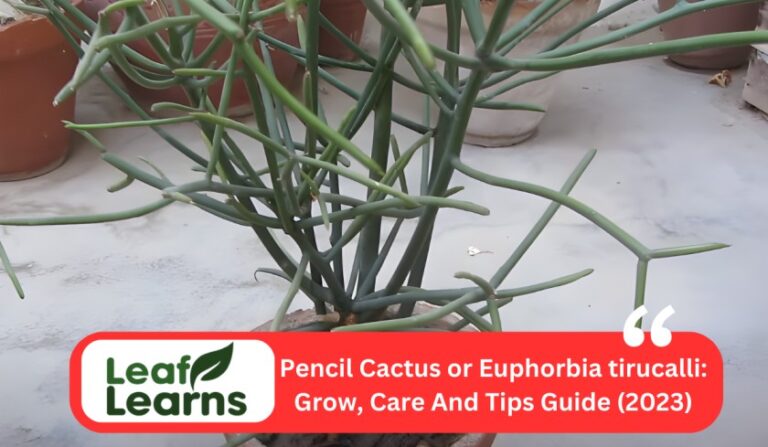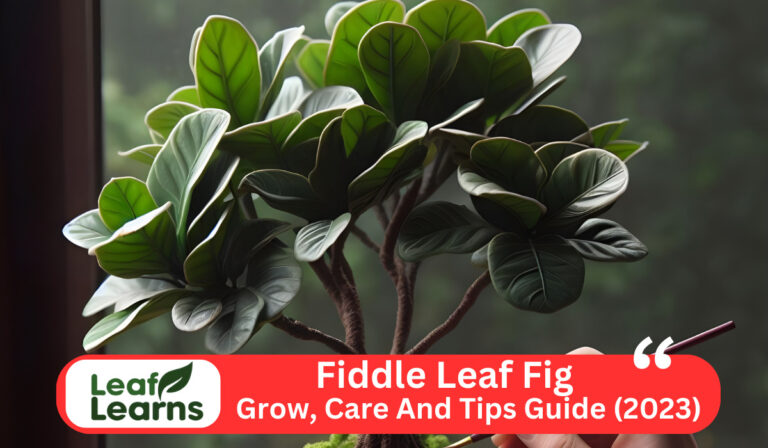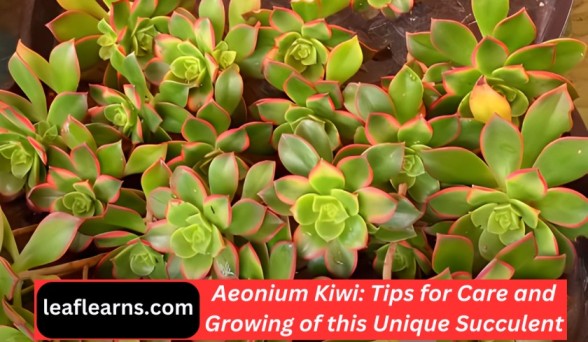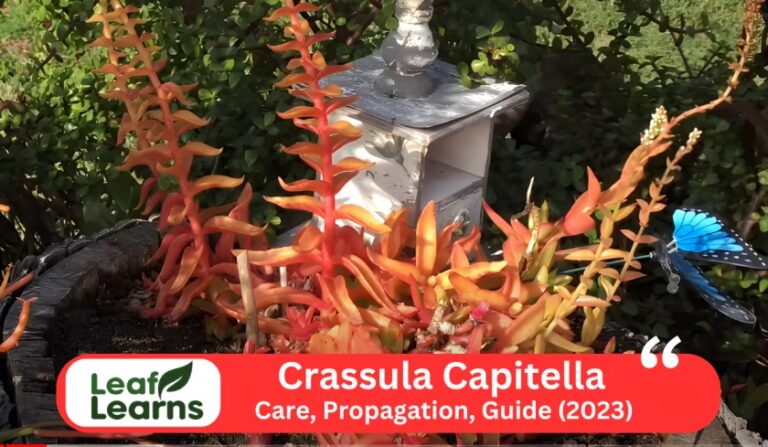Grow and Care for Australian Tree Fern (2023)
The rainforests of eastern Australia are home to the magnificent Australian tree fern (Cyathea cooperi), which has a prehistoric appearance. It stands out in any landscape or garden because of its striking appearance. This fern has a tall, thin stem that resembles a trunk and is covered in brown scales.
It can grow as high as 15 feet or more. It has a lavish crown of graceful, feathery fronds that can reach a length of ten feet at the top of the trunk.
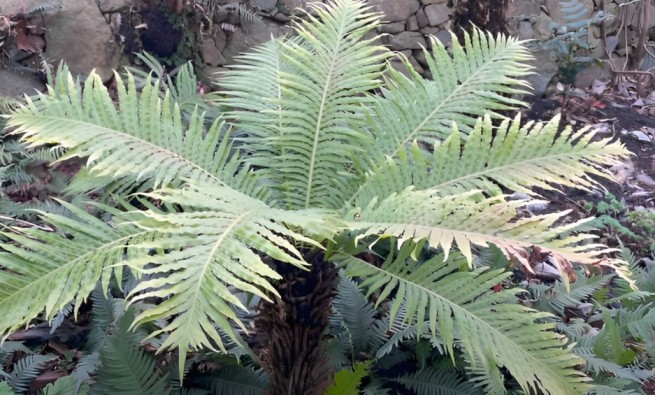
Garden aficionados love it because of the lush, tropical atmosphere these fronds produce. A little bit of the old rainforest is brought to gardens all around the world by thi plant, which thrives in wet, shady conditions.
The Plant is unique to Australia and is quickly expanding. Cyathea cooperi is better suited for the outside since it grows tall, but if there is enough space indoors, it may be grown as a floor plant.
| Common name | Cooper’s Tree Fern, Scaly Tree Fern |
| Scientific Name | Cyathea cooperi |
| Family | Cyatheaceae |
| Distribution | Australia |
| Plant type | Fern |
| Mature Height | Up to 10-30 feet (3-9 meters) |
| Growth rate | Moderate to Fast |
| Leave colour | Dark Green |
| Flower | No flowers |
| Foliage type | Evergreen |
| Propagations | Spores, Division |
| Light requirement | Partial to Full Shade |
| Soil requirement | Moist, Well-Drained Soil |
| Watering Need | Regular, Keep Soil Moist |
| Special features | Large, Arching Fronds |
| Pest and Disease | Aphids, Scale Insects, Fungal Issues |
| Pruning | Remove Dead Fronds as Needed |
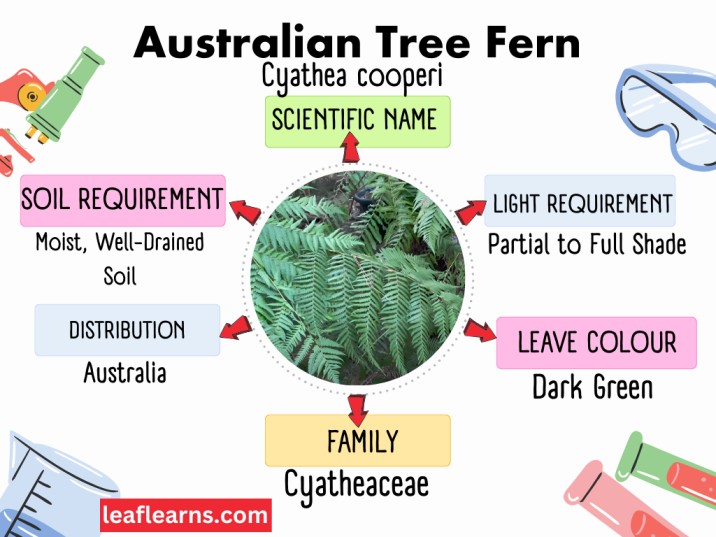
Contents
- 1 What Is Australian Tree Fern?
- 2 Where To Grow Australian Tree Fern
- 3 Planting
- 4 Propagating Australian Tree Fern
- 5 Plant specs
- 6 Australian Tree Fern Care
- 7 Plant Movement
- 8 Repotting
- 9 Size and Growth rate
- 10 Problems
- 11 Understanding Characteristics and Planting Requirements
- 12 Managing Growth and Transplanting: Tips for Care
- 13 Conclusion
- 14 FAQs
What Is Australian Tree Fern?
Around the world, tropical and subtropical climates are home to tree ferns, which resemble trees. Some of them may even be cultivated outside in gardens in milder, warmer temperate climates. However, some people could be lured to growing these inside in colder regions of the planet.
Tree ferns are widely distributed, however those that may be grown in moderate conditions are slightly less common. Due to their popularity in gardens and even indoor spaces, Cyathea cooperi and Dicksonia antarctica are the two species most commonly mentioned when discussing this.
Sphaeropteris cooperi, Cooper’s tree fern, lacy tree fern, and scaly tree fern are other names for Cyathea cooperi. It is indigenous to Queensland and New South Wales in Australia. In USDA zones 8 through 10, it can be grown outdoors, but it can also be cultivated inside.
Other names for Dicksonia antarctica include man fern and soft tree fern. Native to eastern Australia, from southeast Queensland, NSW, and Victoria to Tasmania, it is an evergreen tree fern.
It is tougher and can be grown outside in milder climates, however it might also be grown indoors if there is enough room.

Where To Grow Australian Tree Fern
You must consider their placement extremely carefully if you want to cultivate tree ferns indoors. Make sure there is adequate room and take into account how big the species will eventually get (usually up to about 4-5m in height, 2-5m broad when grown in pots indoors).
Depending on where you live, the climate there, and the room you have, you could decide to keep these trees indoors for the winter or all year.
But be careful to consider the light, temperature, humidity, and other environmental requirements that these tree ferns have.
Light Requirements
Tree ferns can tolerate bright circumstances during cooler seasons with fewer daylight hours, but they also need protection from scorching direct sunlight during the hottest portion of the day. They will thrive inside in an area with indirect light that is bright.
Temperature & Humidity Requirements
Both of these ferns perform well in environments that are between 18 and 26 degrees Celsius and are somewhat warm and humid.
When growing under glass, winter temperatures should not go below 10 degrees, however Dicksonia Antarctica is a bit more resilient and can tolerate a light frost with some protection.
Both species do not perform well with abrupt temperature changes and require temperatures that are rather constant. Therefore, keep them away from draughts and heat sources in your home.
Another crucial factor is humidity, which should be rather high. Again, sudden shifts should be avoided in order to maintain high humidity levels year-round wherever these tree ferns are cultivated.
Soil/ Growing Medium
Tree ferns should be cultivated in wet, freely draining soil or other growth media that is high in humus. When cultivating these tree ferns in pots, be sure that the medium you use has a pH range of neutral to slightly acidic and meets the necessary parameters.
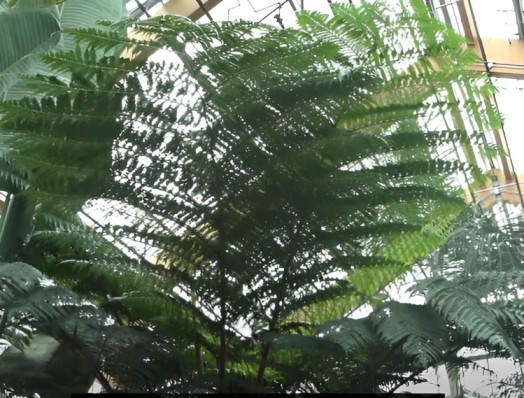
Choosing the Right Location for Your Tree Fern
Exotic and lovely Australian plant may provide a touch of tropical charm to any garden. You should place tree ferns in a spot that receives partial shade throughout the day, since they prefer shade and gentle sun. It will scorch their leaves if they are exposed to bright, intense sunlight.They are quite simple to cultivate and take care of, but for them to flourish, the ideal area must be selected.
In this post, we’ll go over the three important aspects of light needs, soil and drainage, and space and air circulation to take into account when choosing a location for your tree fern.
Planting
Finding a container that will hold just the right amount of moisture for a tree fern while also allowing extra water to readily drain from the base is important.
While you might choose for a plastic pot, glazed ceramic pots can be a more sustainable and environmentally responsible option. Because these ferns require constant moisture, an unglazed terracotta or clay container is not recommended.
When a pot includes one of these tall plants, make sure it is both big enough to hold the present specimen and robust enough to sustain it and not blow over or be easily turned over.
Propagating Australian Tree Fern
The only way to grow this plant is from spores.This tree fern cannot be vegetatively propagated from cuttings. Spores from a mature frond should be collected and placed on paper.
Pour boiling water over soilless potting material in a heat-resistant basin to sterilise it and get rid of any germs that can hinder germination. Before adding the potting mix to a four-inch container, let it drain and cool fully.
Put the spores on the potting soil and cover it with a dome or bag made of plastic.Put the pot somewhere with indirect light and a constant temperature of around 68 degrees Fahrenheit.The spores will take 2 to 6 weeks to germinate, so always keep it wet.
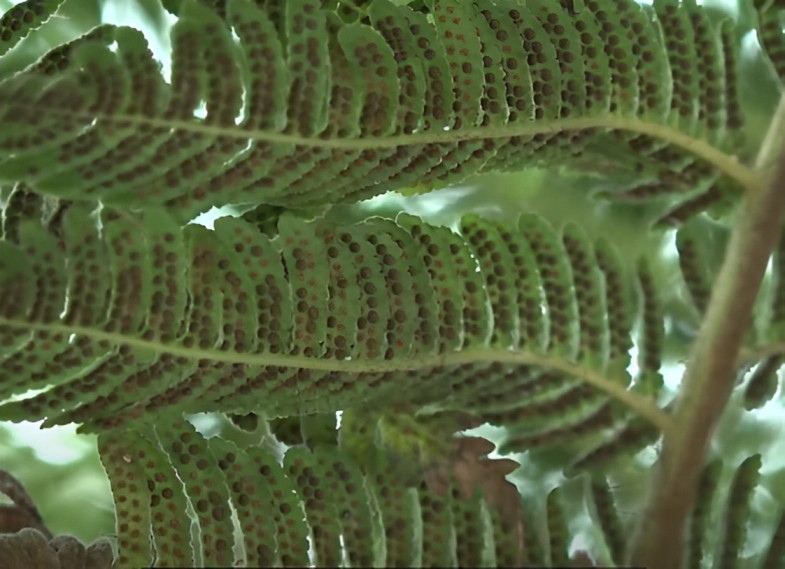
Plant specs
These evergreen trees thrive in full to some shade.They slowly develop to a height of around 15 feet and a width of at least 8 feet.Tree ferns prefer warm, humid climates, and the ideal zone for them is 10.
However, in Zone 9B, you may maintain one in a container and bring it inside during the winter.
Australian Tree Fern Care
This type of plant maintenance is not that difficult. The major tasks to consider are watering, feeding, and, if you put the tree outside in the summer, bringing it inside before the next winter snap. Tree Ferns grow in bright, indirect light, and moderate to high like more than 50% humidity.
Watering
The most important thing to keep in mind when calculating how frequently to water is that this plant require a stable moisture level in the soil but not constant saturation.
One of the trickiest parts of growing tree ferns indoors is getting the watering process just right.When watering, be sure to wet the trunk at the plant’s base rather than the head.
The crown may start to deteriorate if it stays damp for a while. It’s time to water again if the soil seems dry to the touch. Make sure that any extra water may easily drain away.
Light Requirement
Providing filtered sunlight in summer prevents scorching, while indirect light shields against cold stress in winter. Spring and fall are the ideal times for ferns to grow in bright, indirect light.
A large area is best for your plant because of its tall stature.
By mastering the plant’s light requirements, you’ll ensure the fern flourishes in every season, showing off its lush, feathery fronds.
Soil Requirement
This wplant will bloom more splendidly with tailored soil care! In the summer, make sure the soil retains moisture;
in the winter, make sure it drains well to prevent root rot. In the spring, a balanced soil mix fosters growth, while in the fall, organic matter should be added.
You should aim for a pH of 5.5-6.5 and a depth suitable for its majestic height, so you can enhance your green oasis by understanding the Australian-Tree Fern’s delicate soil needs.
Fertilizer Requirement
This plant can be kept healthy all year round with savvy fertilizer care. The spring needs phosphorus for robust root development, while the fall thrives on a balanced fertilizer mix.
In summer, a balanced fertilizer promotes lush frond growth, while winter dormancy suits a low-nitrogen mix. In winter, water whenever the top 12″ of the potting mix is dry. In spring and fall, keep the soil evenly moist and apply a balanced houseplant fertilizer (20-20-20).
Optimal fertilizer use ensures your plant thrives in all seasons, and it’s important to follow the advice of your fern’s tall stature feed consistently, but don’t overdo it.
Potting Requirement
With savvy potting, you can elevate your plant game. In summer, it craves moisture, so keep the soil constantly damp. Winter? Let the top inch dry out between waterings.
The fern needs room to stretch its fronds, so use a well-draining mix. Use a pot that accommodates its tall stature.
Keep the soil moist in spring and fall. If you know how to pot your Australian Tree-Fern properly, you’ll have a lush, magnificent plant all year long.
Temperature and Humidity Requirement
Take your Philodendron Sodiroi to the next level! It likes a warm 65-80°F in the summer, and a cool 60°F in the winter.
Spring and fall? Keep it comfortable at 65-75°F. It prefers humidity between 60-80%, so keep it tall and proud by regulating these temperature.
Feeding
During the spring and summer growing seasons, feed Australian ferns about once a month to encourage healthy development. Utilise a liquid organic plant food, such as compost tea.
Using organic mulch around the trunks at the base of the plants in pots, exactly like you would in the ground, is another smart move. This restores nutrients in the big pot you used as it slowly decomposes.
Even more frequent feedings may be advantageous for larger, more mature individuals. Once they reach a certain size, they can become heavy eaters who, for the majority of the year, may even require feeding every two weeks.

Planting Steps and Techniques
Make sure the top of the root ball is level with the soil before inserting it into the planting hole and covering it with the adjusted soil. Avoid too compacting the dirt while gently firming it around the roots.
To help the soil settle around the fern, water it liberally, but watch out for overwatering, which might destroy the roots.It’s critical to give your fern the right attention and upkeep after planting.
In particular during the warmer months, this plant need frequent irrigation to maintain their moisture levels. To give your fern the nutrition it needs to develop, you may also apply a slow-release fertiliser.
Pruning and Maintenance
Pruning dead or damaged fronds on a regular basis can keep your tree fern looking good and healthy. Any dead, ill, or damaged fronds should be removed with a set of precise pruning shears.
Avoid damaging the stipe at all costs because doing so might impair the plant’s structure. To lessen the chance of fungus infections, keep the space surrounding the plant clear of debris.
Additionally, it’s critical to routinely check your tree fern for any symptoms of illness or pest infestation. Mealybugs, scale insects, and spider mites are typical pests that can harm.
In order to get rid of the pests, spray the plant with an insecticidal soap or oil if you see any infestation symptoms, such as yellowing or drooping fronds.
Plant Movement
You can move Tree Ferns indoors in the summer and then move them outside in the winter. Plant in containers filled with humus enriched soil. So its movement are very necessarily.
Repotting
These tree ferns spread quite quickly. They need to be transferred to a larger container since they can quickly overrun smaller pots.
They should be repotted every year into a larger pot with new growth media inside until they reach the largest size you can support.
Then cease repotting the tree to considerably slow its development, which will extend the amount of time you may keep it inside.
Size and Growth rate
In favorable conditions, the Australian-Tree Fern can grow to impressive heights each year, with an annual growth rate of 2 to 3 feet.
A mature specimen of this striking fern can reach a height of up to 15 feet, creating a stunning focal point in any garden.
Problems
- Low humidity or underwatering may cause Australian Tree-Ferns to develop brown fronds.
- Pests like scale insects can infest ferns, so keep an eye out for them.
- Wilting and decay can result from root rot caused by overwatering.
- Growth can be stunted if fertilizer is applied incorrectly.
Understanding Characteristics and Planting Requirements
To successfully care for plant, understanding its characteristics and planting requirements is essential. These ferns, scientifically known as Sphaeropteris cooperi, are native to Australia and are renowned for their striking, feathery fronds.
When planting a plant, choose a well-draining, acidic soil mix to mimic their natural habitat. They thrive in filtered sunlight or partial shade, making them ideal for indoor or shaded outdoor settings. Watering is crucial, as these ferns prefer consistently moist soil but not waterlogged conditions.
It’s important to keep an eye on the fronds, as browning leaves can indicate issues with watering or insufficient humidity. To promote healthy growth, occasional pruning to remove dead fronds and regular fertilization with a balanced, slow-release fertilizer can be beneficial.
Managing Growth and Transplanting: Tips for Care
One of the key characteristics of this plant is their ability to grow relatively fast under the right conditions. However, their growth rate can vary depending on factors such as temperature, light, and humidity.
Typically, you can expect noticeable growth each year, especially during the warmer months. If you decide to transplant your this plant, be mindful of its root system, which can be extensive. When done correctly, transplanting can help rejuvenate the plant and address issues like overgrowth.
Conclusion
You may successfully grow and care for a beautiful plant in your yard by according to these instructions. These magnificent plants may survive and develop into a focal point of your outdoor area with the right care and attention.
FAQs
Do Australian tree ferns need full sun?
They may also flourish in settings with dappled or partial sun, as long as they have six hours of daylight each day.
Where does the Australian tree fern come from?
It grows naturally in open spaces and forest edges along the coast in north-eastern Australia.
Can Australian tree ferns grow indoors?
If enough room is supplied, Cyathea cooperi can be cultivated as an indoor floor plant.
How long do Australian tree ferns live?
It have been estimated to live more than 500 years.
When Should I Repot My Australian Tree Fern?
Once a year, repot your tree fern to make room for its expanding growth and to add fresh soil. Stop repotting the fern after it reaches its full size to keep it under control.
Should I Prune My Australian Fern?
To preserve the health of the fern, remove any dead or wilted fronds.
Can I Grow My Australian Fern Tree Outdoors?
Yes, the fern will grow outdoors in USDA zones 8 to 11.
Is the Australian Tree Fern Considered Toxic?
Although there is no proof that this specific fern is hazardous, many fern species are, thus caution should be exercised when near children and pets.
What is the Annual Growth Rate of the Australian Tree Fern?
The tree fern has the fastest growth rate of the fern family at up to three feet (0.9 meters) per year


